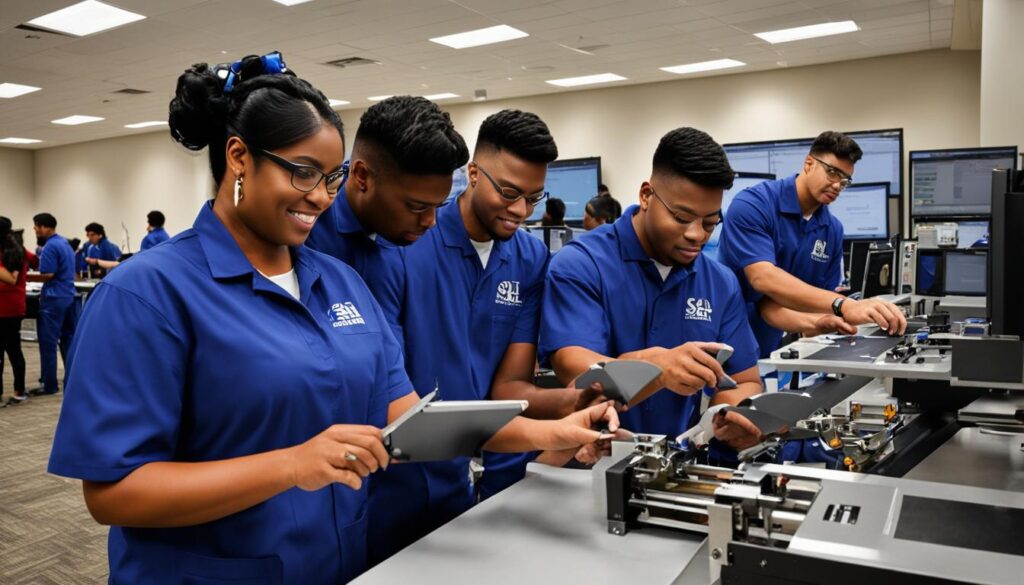Community College Outshines University In today’s competitive job market, choosing between community college and university can have a significant impact on your career prospects and financial future. While both options offer valuable educational opportunities, community college often outshines university in terms of affordability, personalized attention, and job readiness.
One of the major differences between community college and university is the cost of tuition. Community colleges typically offer lower tuition rates compared to four-year universities, making them a more affordable choice for many students. This affordability can save students thousands of dollars in student loan debt and provide a path to higher education without the burden of overwhelming financial obligations.
Another advantage of attending a community college is the more personalized attention students receive. With smaller class sizes and dedicated faculty, community colleges can provide a supportive learning environment where students can receive one-on-one guidance and support. This personalized attention allows students to develop stronger relationships with their professors, who can offer mentorship and guidance throughout their academic journey.
Community colleges also offer a wide range of career programs that are specifically designed to meet the needs of today’s job market. These programs focus on providing hands-on experience and practical skills that are directly applicable to various industries. By offering career-specific education, community colleges prepare students for the workforce and increase their chances of securing meaningful employment.
Additionally, community colleges often have transfer agreements with four-year universities, allowing students to seamlessly transfer their credits and continue their education at a university of their choice. This transferability of credits provides students with the flexibility to start their education at a community college and then transfer to a four-year college or university, ultimately saving them time and money.
Overall, community colleges offer numerous benefits over traditional universities in terms of affordability, personalized attention, and career-focused programs. Whether you’re looking to start your higher education journey or enhance your skills for the job market, community college can provide the tools and support you need to succeed.
Key Takeaways: Community College Outshines University
- Community colleges typically offer lower tuition costs compared to four-year universities.
- Students at community colleges receive personalized attention and mentorship.
- Community colleges provide a wide range of career-focused programs that prepare students for the workforce.
- Many community colleges have transfer agreements with four-year universities, allowing for easy credit transfer and continued education.
- Choosing community college can save students money and provide a strong foundation for future success.
The Transformative Power of Community Colleges in High-Tech Industries
Community colleges play a crucial role in bridging the gap between education and the high-tech job market. Institutions like Lorain County Community College in Ohio have recognized the need to adapt their educational offerings to meet the demands of the rapidly evolving industry. They have designed cutting-edge career-focused programs that prepare students for high-tech jobs in fields such as micro-electromechanical systems (MEMS).
One notable collaboration is Lorain County Community College’s curriculum partnership with Ford, where students gain hands-on experience working with advanced automotive technologies. Such initiatives provide students with the necessary skills and knowledge to excel in the high-tech industry.
Community colleges are known for their flexibility in meeting the diverse needs of students. They offer “Earn and Learn” programs, providing students the opportunity to earn a livable wage while gaining valuable work experience through paid jobs and internships. This not only helps students finance their education but also equips them with practical skills that employers seek.
The commitment of community colleges to provide flexible academic offerings is exemplified by their partnership with the University of Houston. The University Center at LSC-University Park enables students to seamlessly transfer to the University of Houston by offering a curriculum that aligns with the university’s requirements and facilitates a smooth transition.
The Benefits of Community College Education in High-Tech Industries:
- Availability of career-focused programs in emerging fields
- Collaborations with industry leaders for curriculum design
- Flexible academic offerings, including “Earn and Learn” programs
- Opportunities for stable employment in high-tech jobs
- Smooth transfer pathways to renowned universities
Overall, community colleges empower students to thrive in high-tech industries by providing them with the necessary skills, knowledge, and practical experience. Through collaborations with industry leaders, flexible academic offerings, and strong transfer partnerships, community colleges contribute significantly to the workforce and equip students with the tools they need to succeed in the ever-evolving landscape of high-tech industries.
Adapting to the Evolving Job Market: How San Jacinto College is Leading the Way

San Jacinto College in Texas acknowledges the importance of adapting its academic offerings to meet the demands of an ever-changing job market. To ensure the success of its students, the college has taken proactive steps to provide relevant and specialized degree programs, offer comprehensive career services, and optimize the efficiency and affordability of its educational experience.
Reduced Number of Degrees, More Specific Degree Programs
Recognizing the need for more specific skill sets in the job market, San Jacinto College has strategically reduced the number of degrees it offers. Instead, the college has focused on developing more targeted degree programs that align with the evolving needs of industries. By refining its academic offerings, San Jacinto College equips students with the knowledge and skills necessary to excel in their chosen fields.
Comprehensive Career Services Staff
Acknowledging the significance of career guidance, San Jacinto College has invested in a team of dedicated career services staff. These knowledgeable professionals assist students in identifying their career goals, exploring various pathways, and developing strategies for success. By providing tailored guidance and support, the college ensures that students are well-prepared for the job market and can make informed decisions about their future.
Efficient Graduation Rate, Lower Tuition and Fees
In addition to offering specialized degree programs and comprehensive career services, San Jacinto College aims to provide an efficient and cost-effective education. By reducing unnecessary credit hours and streamlining degree requirements, the college enables students to graduate in a timely manner while saving both time and money. This approach not only enhances the overall educational experience but also reduces the financial burden on students.
Lower tuition and fees further contribute to the affordability of a San Jacinto College education. The college strives to make quality education accessible to a wide range of students, ensuring that financial constraints do not hinder their pursuit of academic and career success.
By adapting to the evolving job market, offering more specialized degree programs, prioritizing comprehensive career services, achieving an efficient graduation rate, and maintaining affordable tuition and fees, San Jacinto College demonstrates its commitment to preparing students for the challenges and opportunities of the future.
Community Colleges vs. For-Profit Institutions: A Comparison in Job Market Relevance and Costs
When it comes to job market relevance and costs, community colleges and for-profit institutions offer distinct advantages and disadvantages. Research shows that community college education provides higher job placement rates and greater job market relevance compared to for-profit institutions. Community colleges have been successful in preparing students for the workforce, equipping them with the necessary skills and knowledge that employers value.
One of the primary advantages of community college education is its lower tuition costs. Unlike for-profit institutions, community colleges prioritize affordability, making higher education accessible to a broader range of individuals. This affordability factor is particularly crucial today, as rising student debt continues to burden graduates.
Community colleges also benefit from state funding, which supports their operations and allows them to offer a wide range of academic programs. In contrast, for-profit institutions rely heavily on federal financial aid, often resulting in higher student loan default rates. This reliance on federal aid can contribute to the criticism faced by for-profit institutions regarding their high tuition costs and lower job placement rates.
Despite the challenges of declining student attendance, community colleges have been resilient in attracting students. This can be attributed to their job market relevance and the recognition of their ability to provide quality education at an affordable cost. Community colleges have adapted their programs to meet the evolving demands of industries, offering career-focused education and training that aligns with market needs.
Overall, community colleges have proven to be a valuable pathway for individuals seeking higher education and better job opportunities. Their higher job placement rates, lower tuition costs, and commitment to job market relevance set them apart from their for-profit counterparts. Community colleges continue to play a crucial role in preparing students for success in the job market.
Overcoming Challenges: The Role of Convene in Teams for Community Colleges

Community colleges face various challenges in their day-to-day operations. One of the critical areas where these institutions can benefit is in communication and decision-making processes. Convene in Teams is a digital platform designed specifically to address these challenges, offering community college executives and boards enhanced communication, streamlined decision-making, and access to data-driven insights.
With Convene in Teams, community college leaders can foster enhanced communication among faculty, staff, and students. Real-time collaboration features enable seamless sharing of ideas, materials, and updates. The platform facilitates efficient document sharing, ensuring that everyone has access to relevant information, contributing to a more connected and informed community college environment.
Streamlining decision-making processes is crucial in any organization, and community colleges are no exception. Convene in Teams provides features like voting systems, task management tools, and shared calendars that help streamline decision-making processes. Decision-makers can view and track progress, assign tasks, and receive real-time updates, ensuring efficient and informed decision-making for the benefit of the entire institution.
Data-driven insights play a vital role in strategic planning and resource allocation. Convene in Teams offers robust analytics and reporting capabilities, providing community college leaders with valuable insights into various aspects of their institution. These data-driven insights enable evidence-based decision-making, optimizing resource allocation, and fostering continuous improvement.
“Convene in Teams revolutionizes the way community colleges operate. It empowers leaders to overcome challenges through enhanced communication, streamlined decision-making, and data-driven insights.” – Dr. Sarah Taylor, President of XYZ Community College
Community colleges can leverage the power of Convene in Teams to navigate their hurdles and strive for excellence. By utilizing this digital platform, these institutions can strengthen their internal communication networks, improve decision-making processes, and make strategic choices based on reliable data insights. Ultimately, Convene in Teams empowers community colleges to fulfill their mission of providing accessible and quality education to their students.
Benefits of Convene in Teams for Community Colleges:
| Enhanced Communication | Streamlined Decision-Making | Data-Driven Insights |
|---|---|---|
| Real-time collaboration | Voting systems | Robust analytics |
| Seamless document sharing | Task management tools | Reporting capabilities |
| Improved information sharing | Shared calendars | Evidence-based decision-making |
Lowering State Funding: Impact on Community College Operations

Community colleges heavily rely on state funding to support their academic and operational needs. Adequate financial support is crucial for community colleges to provide a quality education and comprehensive student services. However, many states have made budget cuts to higher education, resulting in significant challenges for community college operations.
The decrease in state funding has led to program cuts, faculty reductions, and decreased student services. Without sufficient financial support, community colleges are forced to make difficult decisions in order to sustain their operations. Program cuts limit the variety of academic offerings available to students, potentially compromising their educational opportunities.
Faculty reductions have a direct impact on the quality of education provided. With fewer faculty members, community colleges may struggle to maintain small class sizes and personalized attention for students. This can hinder students’ academic progress and limit their ability to receive the guidance and support necessary for success.
Decreased student services further compound the challenges faced by community colleges. Students rely on support services such as counseling, tutoring, and career guidance to thrive academically and transition into the workforce. However, the lack of funding may result in reduced availability and accessibility of these crucial resources.
The consequences of decreased state funding are far-reaching and can impact both students and the wider community. Community colleges play a vital role in providing affordable and accessible education, particularly for non-traditional or underserved populations. When funding is constrained, these institutions may struggle to fulfill their mission of promoting educational equity and workforce development.
Despite these challenges, community colleges strive to find innovative solutions and alternative sources of funding to sustain their operations and support their students. Collaborations with local businesses, grant applications, and community partnerships are just a few ways community colleges are actively seeking additional financial support.
“The impact of state funding reductions goes beyond the institutions themselves. It affects students’ educational opportunities and their ability to achieve their career goals. It also affects the communities these colleges serve, as they rely on a well-educated workforce for economic stability and growth.”
Comparison of Community College Operations Before and After State Funding Reductions
| Operational Aspect | Before State Funding Reductions | After State Funding Reductions |
|---|---|---|
| Programs and Courses | Diverse and expansive | Limited and reduced |
| Faculty | Adequate numbers to support small class sizes | Reduced faculty, larger class sizes |
| Student Services | Comprehensive and accessible | Reduced availability and accessibility |
| Education Equity | Supporting non-traditional and underserved populations | Challenges in providing accessible education |
Community colleges continue to advocate for increased state funding to ensure the provision of quality education and comprehensive student support services. State policymakers and stakeholders must recognize the critical role community colleges play in their communities and prioritize adequate financial support for these institutions.
Decline in Student Attendance: Reasons and Implications for Community Colleges

Community colleges have been facing a decline in student attendance, which has significant reasons and implications for these institutions. Several factors contribute to this decline, including increased job opportunities, rising tuition costs, competition from online educational platforms, and the impact of the COVID-19 pandemic.
The availability of job opportunities has diverted potential students away from pursuing higher education at community colleges. With a strong job market, individuals may opt for immediate employment, delaying or forgoing enrollment in community colleges. This trend can be attributed to the desire for immediate income and the perception that job opportunities alone can provide long-term career success.
Rising tuition costs pose another challenge for community colleges. As the cost of higher education continues to increase, it becomes more difficult for students to afford tuition fees. This financial burden can deter potential students from enrolling in community colleges and seeking alternative educational options.
Additionally, community colleges face competition from online educational platforms that offer flexible learning options. These online platforms provide convenience and accessibility, attracting students who prefer the flexibility of remote learning over traditional classroom-based education. The convenience and cost-effectiveness of online learning make it an appealing alternative to community colleges for some prospective students.
Furthermore, the impact of the COVID-19 pandemic has significantly affected student attendance at community colleges. The disruptions caused by the pandemic, including remote learning challenges and uncertain economic conditions, have prompted many students to postpone or reconsider their educational plans.
The implications of declining student attendance are far-reaching for community colleges. The decrease in enrollment affects the financial viability of these institutions, as tuition fees represent a significant portion of their revenue. With fewer students, community colleges may face challenges in funding operations, maintaining a diverse range of courses, and providing comprehensive student support services.
Overall, the decline in student attendance at community colleges calls for strategic measures to reverse the trend and ensure the continued success of these institutions. It is crucial for community colleges to address the factors contributing to declining enrollment, such as offering competitive tuition rates, enhancing the quality of education and support services, and adopting innovative approaches to attract and retain students.
The Promise of Community Colleges: Better Job Opportunities and Success in the Workforce

Community colleges offer a wide range of programs and career-focused education that leads to better job opportunities and success in the workforce. These institutions excel in preparing students for the demands of the job market, equipping them with the skills and knowledge needed to thrive in their chosen fields.
Job placement data consistently shows that community college graduates enjoy higher job placement rates compared to those from for-profit institutions. This success can be attributed to the community college’s emphasis on providing practical, hands-on training that aligns with industry needs. Students gain valuable experience through internships, co-op programs, and industry partnerships, enhancing their employability upon graduation.
One of the key advantages of community colleges is the diverse range of courses they offer. Students can choose from a wide array of academic programs, ranging from traditional fields to emerging industries. This flexibility allows individuals to pursue their passions, explore new interests, and pivot their career paths without committing to a four-year program.
But it’s not just about academic offerings. Community colleges also foster a vibrant campus community, creating an environment conducive to learning and personal growth. Students have the opportunity to engage in extracurricular activities, clubs, and events that enhance their social and interpersonal skills. This holistic approach to education prepares graduates to thrive not only in their professional lives but also in their personal and civic engagements.
“Community colleges provide an inclusive setting where students from diverse backgrounds come together to learn and grow. This diversity fosters a rich learning environment, encouraging cross-cultural understanding and collaboration, which are vital skills in today’s global workforce.”
The success of community college graduates in the job market is a testament to the quality education and support they receive. These institutions prioritize student success, offering comprehensive career services that include resume building, interview preparation, and job placement assistance. By equipping students with the necessary tools and resources, community colleges play a crucial role in bridging the gap between education and employment.
When contemplating higher education, students face the decision of whether to attend a community college first or head directly to a traditional university. Community colleges, often two-year institutions, offer distinct advantages.
They provide a cost-effective option, allowing students to complete college credits before deciding to transfer to a four-year college or university. The benefits of attending a two-year community college include smaller class sizes, available at community colleges, providing a more personalized learning experience.
Moreover, community colleges typically have articulation agreements with universities, streamlining the transfer process. Students attending community colleges can choose between community college or university right out of high school, with the option to transfer to a university to complete a bachelor’s degree.
Starting at a community college can be a great pathway, especially considering that community college credits can save both time and money. The major differences between community colleges and universities lie in the class size, program offerings, and the flexibility community colleges provide, making them an attractive option for those seeking a cost-effective and adaptable route to higher education.
Also Read : Unlock Success With Mastering Engineering Skills
Conclusion
Community colleges provide numerous advantages in today’s job market. With their job market relevance, affordable education, transfer opportunities, and career-focused programs, these institutions have become a valuable resource for students seeking success in their chosen fields.
Community colleges have adapted to the changing demands of the job market, equipping students with the skills and knowledge necessary to thrive in their careers. Their programs are designed to meet industry needs, ensuring graduates are well-prepared for the workforce. Additionally, community colleges offer affordable education options, making higher education more accessible to a wider range of students.
Transfer opportunities are another significant benefit of community colleges. Many students choose to start their academic journey at a community college and then transfer to a four-year university to complete their degree. This pathway allows for a seamless transition and saves students money on tuition.
Furthermore, community colleges prioritize career-focused programs that align with the needs of the job market. These programs provide students with specialized knowledge and practical skills that directly translate into employment opportunities. By embracing digital platforms like Convene in Teams, community colleges can overcome challenges and enhance their efficiency, leading to better decision-making and improved outcomes for students.
FAQs
Q: What is the difference between a community college and a university?
A: Community colleges typically offer two-year associate degrees and vocational training programs, while universities provide four-year bachelor’s degrees and advanced degrees.
Q: What are the pros and cons of attending a community college?
A: Pros of attending a community college include lower tuition costs, smaller class sizes, and flexible schedules. Cons may include limited course offerings and fewer campus amenities.
Q: How does the class size at community colleges compare to that at universities?
A: Class sizes at community colleges are usually smaller, allowing for more personalized attention and interaction with instructors.
Q: What is the advantage of attending a community college before transferring to a four-year university?
A: Attending a community college first can be an economical way to complete general education requirements and transition to a university with potentially lower debt.
Q: How can a community college degree help in the job market?
A: A community college can provide practical vocational training and an associate degree, which may lead to immediate employment opportunities.
Q: Is it better to attend a community college or a university for the first two years of college?
A: This decision depends on individual goals and circumstances. Community colleges may offer cost savings and smoother transitions for some students.
Q: Can community college students easily transfer to a four-year university?
A: Many community colleges have articulation agreements with four-year institutions, simplifying the transfer process for students.
Q: What are the differences in the college experience between attending a community college and a four-year university?
A: Community colleges often provide a more focused, practical education with smaller campus environments, while universities offer a broader array of programs and a traditional campus experience.
Q: How does the cost of attending a local community college compare to that of a public university?
A: Tuition at community colleges is generally more affordable than that of public universities, offering a cost-effective option for higher education.
Q: What is the value of obtaining an associate degree from a community college?
A: An associate degree can qualify individuals for certain careers and serve as a stepping stone to pursuing higher education or more advanced degrees.
Q: What is the difference between community college and a university?
A: Community colleges typically offer two-year degree programs, while universities offer four-year degree programs and beyond. Community colleges also tend to have smaller class sizes and more flexible schedules.
Q: Should I attend a community college first before transferring to a university?
A: Attending a community college first can be a cost-effective way to complete general education requirements and explore potential career paths before transferring to a four-year university.
Q: Are there any advantages to attending a community college over a university?
A: Yes, community colleges often offer lower tuition costs, more personalized instruction, and the flexibility to attend classes part-time while juggling other responsibilities.
Q: What are the benefits of attending a four-year university over a community college?
A: Four-year universities typically provide a more traditional college experience, with a wider range of degree programs, research opportunities, and access to a broader network of resources and facilities.
Q: How can attending a community college first impact my job prospects?
A: Attending a community college can help students gain practical skills and certifications that are directly applicable to specific industries, making them more competitive in the job market.
Q: Is it better to attend a community college or a university for a specific career path?
A: It depends on the career path and individual circumstances. Community colleges are often praised for their vocational programs and job-focused training, while universities offer a more comprehensive range of academic and professional degrees.
Q: Can I transfer from a community college to a four-year university?
A: Yes, many community colleges have transfer agreements with four-year universities, allowing students to seamlessly transfer credits and continue their education at a higher level institution.
Q: What is the role of community colleges in the overall education system?
A: Community colleges play a vital role in providing accessible and affordable post-secondary education, serving as a gateway for many students to pursue higher education and career advancement.
Q: Are there any misconceptions about community colleges that need to be addressed?
A: Community colleges often don’t receive the same level of prestige as universities, but they can provide high-quality education, practical skills training, and a valuable starting point for many students’ academic journeys.
Q: How can community colleges and universities collaborate to benefit students?
A: Collaboration between community colleges and universities can lead to improved transfer pathways, joint degree programs, and expanded opportunities for students to seamlessly transition between institutions and pursue their educational goals.
Source Links
- https://www.communitycollegereview.com/blog/community-colleges-bigger-buck-bang-than-for-profits
- https://www.newsnationnow.com/us-news/education/community-colleges-adapting-modern-economy/
- https://www.linkedin.com/pulse/challenges-community-colleges-face-how-convene-teams-can-henderson